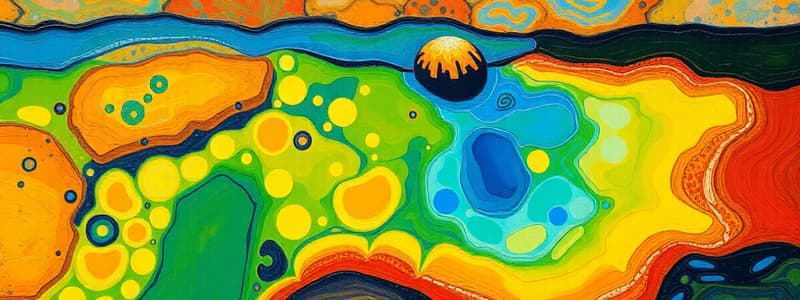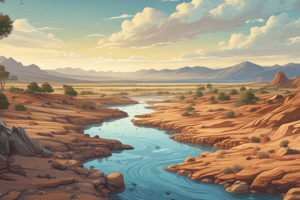Podcast
Questions and Answers
What is the primary function of rock holes for Aboriginal people living in arid areas of Australia?
What is the primary function of rock holes for Aboriginal people living in arid areas of Australia?
- They provide essential water supply. (correct)
- They are used for spiritual rituals.
- They act as landmarks for navigation.
- They serve as a source of food.
What factor can NOT influence the amount of water flowing from springs?
What factor can NOT influence the amount of water flowing from springs?
- Amount of rainfall.
- Human water extraction.
- Temperature of the climate. (correct)
- Water pressure in the aquifer.
Which stage of a river is characterized by the formation of meanders?
Which stage of a river is characterized by the formation of meanders?
- Middle course. (correct)
- Estuary stage.
- Lower course.
- Upper course.
In which stage does a river collect and move larger amounts of soil and gravel?
In which stage does a river collect and move larger amounts of soil and gravel?
What describes groundwater?
What describes groundwater?
What is a confluence in relation to rivers?
What is a confluence in relation to rivers?
How is water typically brought to the surface from an aquifer?
How is water typically brought to the surface from an aquifer?
What happens to the speed of a river as it reaches its lower course?
What happens to the speed of a river as it reaches its lower course?
What is created by the sedimentation process in the middle course of a river?
What is created by the sedimentation process in the middle course of a river?
What makes surface water potentially unsafe to drink?
What makes surface water potentially unsafe to drink?
Which of the following sources is NOT a form of surface water?
Which of the following sources is NOT a form of surface water?
How does a river shape the land over time?
How does a river shape the land over time?
What precaution should be taken before using rainwater for drinking?
What precaution should be taken before using rainwater for drinking?
Which of the following is true about rock holes?
Which of the following is true about rock holes?
What type of water collection method can possibly lead to contamination?
What type of water collection method can possibly lead to contamination?
Which statement about surface water is false?
Which statement about surface water is false?
Flashcards
Water cycle
Water cycle
The continuous movement of water on, above, and below the surface of the Earth.
Ground water
Ground water
Water that is stored underground in layers of rock and soil.
Surface water
Surface water
Water found on the surface of the Earth, like in rivers, lakes, or dams.
Aquifer
Aquifer
Signup and view all the flashcards
Spring
Spring
Signup and view all the flashcards
Waterhole
Waterhole
Signup and view all the flashcards
Bore
Bore
Signup and view all the flashcards
Rock hole
Rock hole
Signup and view all the flashcards
Confluence
Confluence
Signup and view all the flashcards
Erosion
Erosion
Signup and view all the flashcards
Meanders
Meanders
Signup and view all the flashcards
Upper Course
Upper Course
Signup and view all the flashcards
Middle Course
Middle Course
Signup and view all the flashcards
Lower Course
Lower Course
Signup and view all the flashcards
Floodplain
Floodplain
Signup and view all the flashcards
Study Notes
Water Sources
- Water comes from two main sources: ground water and surface water
- Ground water is water found beneath the earth's surface, often in aquifers
- Water seeps through soil and rock layers to reach underground reservoirs
- Borings or wells are used to access ground water
- Water from bores may not be suitable for drinking without treatment
Surface Water
- Surface water collects on the Earth's surface
- Examples include rivers, lakes, dams, reservoirs, and waterholes
- Rainwater collects to form surface water
- Surface water may not be safe for drinking due to potential contaminants
- Rainwater tanks collect surface water but may require treatment before consumption
Other Water Sources
- Waterholes and rock holes are natural features where water collects
- These provide crucial water supplies, particularly in arid regions
- Springs naturally occur where water emerges from underground aquifers
- The water flow in springs depends on factors like aquifer pressure, rainfall, and human water abstraction
River Features
- A river is a large stream of water flowing over land
- Rivers are categorized into upper, middle, and lower courses
- The Upper Course: characterized by rapid flow, erosion, and canyon/valley formation
- The Middle Course: characterized by gentler slopes, increased size, and formation of meanders and islands
- The Lower Course: characterized by slow flow, deposition of eroded material, shaping of floodplains, and formation of deltas as it flows to the sea
Studying That Suits You
Use AI to generate personalized quizzes and flashcards to suit your learning preferences.



